Crossing the Chasm Without Burning Out: Leadership in the New World
Old World/New World
Leaders today are facing complexities that are unprecedented and unpredictable. Many of the leaders I work with are feeling overwhelmed and are at risk of burn-out as they constantly wrestle with the question, “How do I respond to what is being asked of me, when everything is constantly changing and the old ways of working are no longer working?”
As a former CEO of a highly complex, international company, I found myself caught between “old world” thinking (control and command) and “new world” ways of being (consciousness, equivalence, and transparency). Even with the best of intentions, I ended up with adrenal burn-out from trying to manage current problems while evolving into new solutions. This led me to a deep-dive into my inner process of healing and transformation alongside an exploration of organizational structures and what it takes for true systemic healing. Working with leaders, I continuously see the same overwhelm and burn-out pattern creeping in as many face the challenge of striving to create new world structures and ways of leading while still entrenched in an old world paradigm.
As we witness the breakdown of our systems and structures, the question of how to move forward is more pressing than ever. We are being squeezed into rapid change that demands a response. There’s no more waiting until “some day” or continuing with business as usual.
The Rewiring of Power
My perception of the upheaval we are experiencing in the world is about the rewiring of power. We are all recovering from a collective trauma of power-over/under dynamics. The basic structure of domination systems has been prevalent for at least 5,000 years, since the rise of the great conquest states of Mesopotamia around 3,000 BC (Walter Wink). We are just beginning to wake up to the current systems of power-over/under that have become the status quo. This, combined with the increased rate of change, is causing enormous stress that we can all palpably feel.
When faced with such challenges, there is a tendency to meet chaos with control - to try to fix the situation with ready-made solutions. We've been educated, trained and rewarded for this! However, organizations are living systems which require a more dynamic way of working, allowing them to self-regulate and continuously learn from themselves in order to be sustainable and thrive amidst constant change.
“Success will no longer be equated with your ability to withstand change, but by your willingness to be transformed by it.”Laureen Golden
Along with the need to create new structures, the nature of leadership is evolving. Margaret Wheatley refers to this change as a shift from “hero to host” (Leadership in the Age of Complexity). Old structures demanded that leaders come up with and enforce solutions, which can be slow, cumbersome and siloed. Innovative leaders are finding that ways forward are best accessed through “power-with” structures, which tap into the collective intelligence of their teams. Adaptive, agile organizations are discovering that distributed power is the way forward, in place of the centralization of power and decision-making through one individual. This is good news for leaders who are realizing that it no longer works for them to “carry the organization on their back”.
Power-with Structures
In the shift from power-over to power-with, innovation and productivity naturally arise:
Self-correcting structures allow teams to adapt quickly to new conditions and grow through self-learning feedback loops
Efficiency increases when teams closest to the task figure out how to best get the work done
An inter-linked structure ensures accountability and alignment with the organization’s aim (power-with organizations do not need to be horizontal)
When all voices are heard, the collective wisdom and experience of the group is accessed
Inclusive processes lead to more engaged, powerful strategies rooted in purpose and meaning
Through proper empowerment and delegation, leadership deepens within your teams
In a culture of trust, feedback flows more easily throughout the organization or community
Some examples of power-with structures include Sociocracy, Holacracy, Agile, and Teal.
In our current context of constant change, these approaches offer organizations a structure that provides both stability and flexibility, fostering an agile environment required to successfully navigate the waters of change in our VUCA* world. (*volatile, uncertain, complex and ambiguous).
Not sure where to begin? I recommend starting with adding “rounds” to your meeting format so that everyone has a turn to speak. The two minute video below will help you introduce it in your next meeting.
Would you like to know some easy ways to invite others to experiment using Sociocracy? The 2 minute video below will help you with some first steps that won’t add more stress or disruption to your organization.
--------------------
Deep gratitude to:
Laureen Golden: Inspiration, Coherence and Relevant Resources
Juna Wesley: Images
Maxine Wesley: Editing


